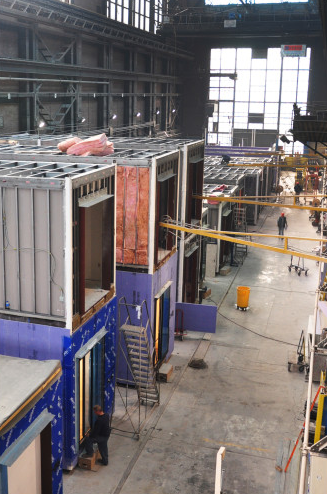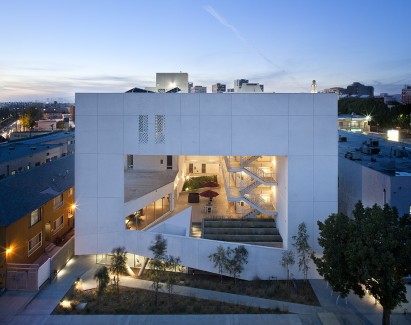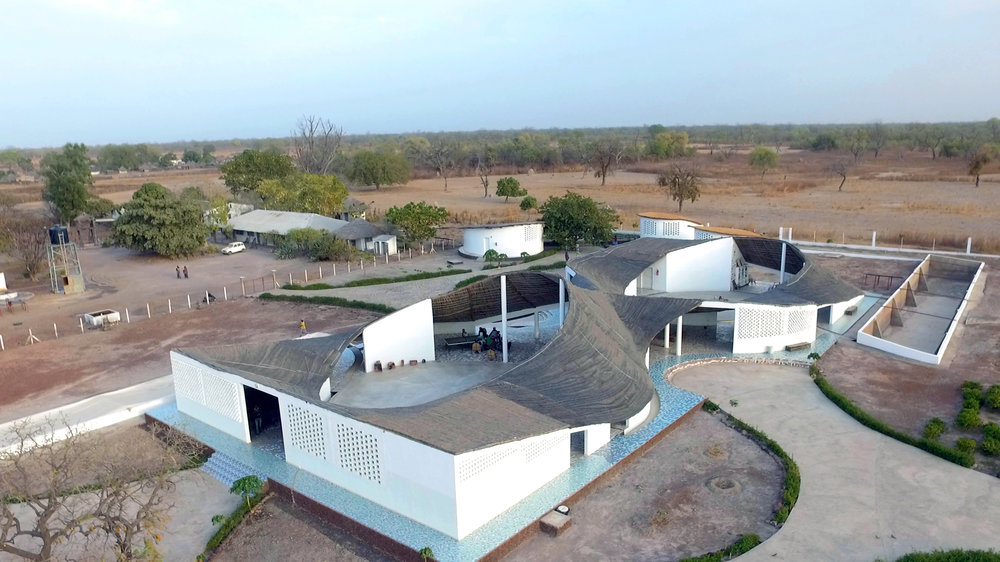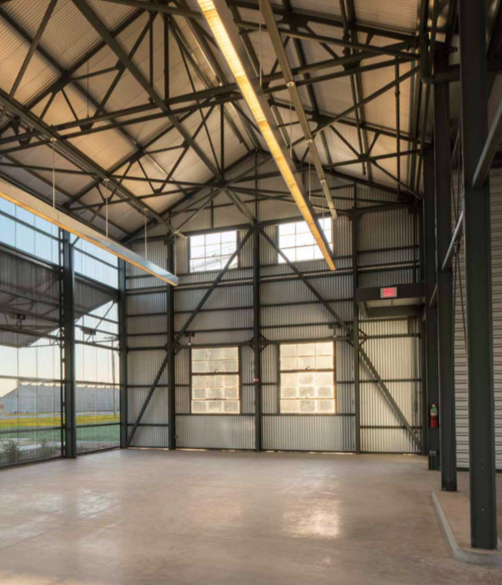Each year AIA National the 2017 Architecture program celebrates the best contemporary architecture regardless of budget, size, style, or type. These stunning projects show the world the range of outstanding work architects create and highlight the many ways buildings and spaces can improve our lives. Here are four 2017 winners highlighted by Pittsburgh’s own Bea Spolidoro, AIA who was invited to participate on this year’s jury.
Last summer, I was invited to be a juror for the 2017 Institute Honor Awards for Architecture with other eight professionals. The jury typically features architect members of the AIA and one non-architect, acting as an allied professional and client representative. At the time, I was serving as the Associate AIA member of the jury.
When signing a contract with a client, the obligation for the architect is not to be perfect, but just potentially as messy as anybody else – the average architect. Despite that, when trying to win clients, architects need to present themselves as unique, more qualified than others, and the best in their specialty (which can lead to trouble through overselling their skills).
It takes a lot of effort to be an architect, so why be “average”?
Luckily, there is a dedicated structure, organized by the AIA National, allowing architects to showcase their extraordinary abilities.
Being part of the jury is a huge learning opportunity. I was particularly impressed by the thoughtfulness of our discussions, lead by Chair Mark Reddington, FAIA, a partner of Seattle-based LMN Architects.
Mr. Reddington noted in our first meeting that many nice photos were submitted, but not all were necessarily representing winning projects. Our goal as a jury was to select projects able to make meaningful statements, and award the design that strives for something transcendent.
We also highlighted how there was a wide range of budgets, available for different types of projects. It was the “mileage” of a building, though, to guide our conversation: the jury particularly praised the ability to do good design, with a wise management of money and resources.
The quality (and the quantity) of the submissions was overwhelming, but we were always aligned on the features a winner should have.
Affordability was mentioned often, not only in regard to the overall budget, but also in relation to the price per square foot, and the ability to deliver a well-coordinated product, beautiful and sustainable, with modest funding.
Sustainability, as well, was a major factor in every decision, and many members of the jury have direct experience in sustainable architecture. The Awards criteria, in fact, quote the AIA 2030 commitment, which is a fundamental component of what is deemed to be good design today.
To afford (v.) comes from old Middle English verb aforth, which means, “to put forth, contribute; but also to carry out, and accomplish”. These definitions sum up with the more modern meaning of “that can be paid for”. Therefore, “affordable projects” should be intended, here and always, as those that go beyond a typical approach to building, and contribute to the construction field with some exemplary solutions.
They pursue a construction philosophy that can be repeated many times, in different places, and that can be shared between different communities and environmental conditions.
Affordable design is good design that can be paid for, and that society can bear – from a social, economical and physical point of view. Very much like sustainability, affordability is not just a label; it is rather an attitude, manifested along construction.
Of all the 11 awarded projects for the 2017 edition of the Honor Awards of Architecture, four were affordable in strong and exemplary ways, capturing different positions on the theme and are highlighted below. You can read the complete descriptions of these and all the other winners in AIA ARCHITECT Magazine, who covered all the Awards, in January 2017.
 Carmel Place
Carmel Place
New York, NY
Photo courtesy nArchitects
Designed by nARCHITECTS, Carmel Place is an “all-inclusive co-living” structure, offering 32 furnished and unfurnished units. Located in Manhattan, it opened in June 2016.
Carmel Place features modular construction that was executed offsite, under controlled conditions with a repetitive process (view the units being constructed at left, in the Brooklyn Navy Yard. Photo courtesy nArchitects). The foundations were built on site and the modules were then shipped and mounted in place, in shorter times and with reduced noise and disruption to neighbors, compared to typical construction. Carmel Place is now the tallest modular structure in Manhattan.
It is possible to rent different unit types and some apartments are market rate units. Half of the units are Section 8 units for homeless veterans.
The developers behind Carmel Place wanted to create a very ‘New Yorker’ experience of micro living, extremely urban, with shared amenities that would appeal a young population. Amenities include bike rooms, a lounge space, fitness area, and roof terrace: of course, there is no more affordable entertainment than the sight of New York itself!
The apartments are small and the compact design is inherently efficient. In fact, Carmel Place was one of the many efforts to address the Bloomberg administration’s New Housing Marketplace Plan, which aims to better respond to the increasing number of one-person households, which is an ongoing trend that is not sustainable per se. This is addressed at Carmel Place by the shared amenities.
Carmel Place features overhead storage, folding beds, integrated and transformable furniture, and the general amenities you need in a house, squeezed in units between 260 and 360 square feet.
There are currently no available units. Prices for units start in the $2,600’s. Lease durations are for 1 and 2 years only. Another structure in Long Island City will open soon.

The Six Affordable Veteran Housing
Los Angeles, CA
Photo courtesy Tara Wujcik
The Six Affordable Veteran Housing (also known as “The SIX”) is comprised of 52 residential units, with support services and rehab for disabled veterans in Los Angeles. Invented by the pilots flying during World War I, “I’ve got your six” means “I’ve got your back” in the military field. The fighter pilots used to refer to the rear of an airplane as the 6 o’clock position. As directly behind you is the most exposed position you need a pal to cover that and, once back home, also a good housing solution able to support the return to a “normal” life.
The collective of architects at Brooks+Scarpa designed the residences thinking of an interactive space, community-oriented, able to serve its residents. The project is also strongly connected with the surrounding community, tightly fitting between two existing buildings, and is at a walkable distance from adjacent services. It features a large public courtyard in the center, where vets can meet and connect with each other.
In addition to the affordability of the rent, the complex is well designed and has a LEED certification, featuring many sustainable solutions that enhance energy efficiency. The residences offered to the veterans are clearly above the average housing levels veterans might typically find.
The AIA National website notes that this “vital project provides high-quality sustainable housing to a population that would otherwise be forced to leave the community due to the very high costs of living.” In times where gentrification is a real threat, and entire communities are forced to leave their historic neighborhoods because of prices inflation, a project like The SIX sends a strong message that it is still possible not only to retain a population but also to welcome it back.

THREAD: Artists’ Residency and Cultural Center
Sinthian, Tambacounda, Senegal
Photo courtesy Toshiko Mori
The submissions for 2017 featured a variety of projects supporting communities in Africa and Asia. Each project was bringing relief to areas challenged by either the consequences of manmade mistakes or nature inclemency.
THREAD: Artists’ Residency and Cultural Center was a project which embraced good design, an effective solution, sustainability, affordability and cultural thoughtfulness.
Toshiko Mori Architect received an award for the creation of residential spaces for artists, an agricultural training hub, and a gathering space for the people of the village of Sinthian.
Senegalese doctor Magueye Ba was already running a medical center and an elementary school, in the region of Tambacounda. Supported in the construction by the Josef and Anni Albers Foundation, THREAD adds more culture – international and local artists- to this place, as well as a way of collecting water, a vital component for the agricultural community. THREAD is intended to be a flexible space, with many functions including a library, dedicated children’s areas, and a phone-charging spot.
The project features local materials and techniques, with a very captivating roof shape, that serve as a rain collector connected with pools for storing the water. According to the AIA website “as a result, a new association of 100 women has been able to raise crops at THREAD during the dry season, further supporting their families and helping pay fees for their school-age children”.
Construction of feature elements of the center was performed on site and involved the local community so that any future maintenance needed could be performed by them. Villagers also formed the clay bricks for the facade on-site. Locally grown and harvested thatch was layered on top of a locally sourced bamboo substructure, providing a low cost and sustainable building solution representative of traditional construction techniques.
 The Gin at the CO-OP District
The Gin at the CO-OP District
Hutto, TX
Photo courtesy Antenora Architects
Amongst the awarded projects, The Gin is one of the most affordable in terms of construction price. Antenora Architects LLP designed and brought it to life for only $126/square foot.
This is a mix of construction, demolition, disassembling, and reuse of an existing structure. The final result is an open-air building, yet covered, with no mechanical systems. In the Texas weather, this solution can accommodate a variety of performances basically all year long.
The Gin can be rented for public and private events, and it aims to serve the community; very much in line with a motto from Antenora’s website, claiming their work is “architecture for people”.
Cities like Pittsburgh, with a more inclement weather and with plenty of old industrial structures, can still get inspiring lessons from a project like this.
The Gin building performed a selective demolition on a pre-existing industrial complex. The project followed a masterplan developed for the entire site (the “CO-OP District”) to be realized in phases.
Secondly, despite the historic qualities and the opportunities to work with old structures, Pittsburgh has often opted for a complete demolition of historic properties, rather than re-interpreting them. The Tom Ayoob building in the Strip District, as one example among many possible, was able to survive a big explosion in 1936, but not the decision that it was too rotten to be saved in 2014. The photos of the construction of The Gin are a great lesson of what is “worthy” of being saved, and possible ways to save the unimaginable, if we approach it with an open-minded perspective.
The photos of the construction of The Gin are a great lesson of what is “worthy” of being saved, and possible ways to save the unimaginable, if we approach it with an open-minded perspective. 2016 Design Pittsburgh Award winner The Discovery of Bay 4 from Rothschild Doyno Collaborative is a good local example of this.
Saving the past is always affordable – one way or the other. Narrow-minded and uncreative business plans make this too expensive to achieve.

